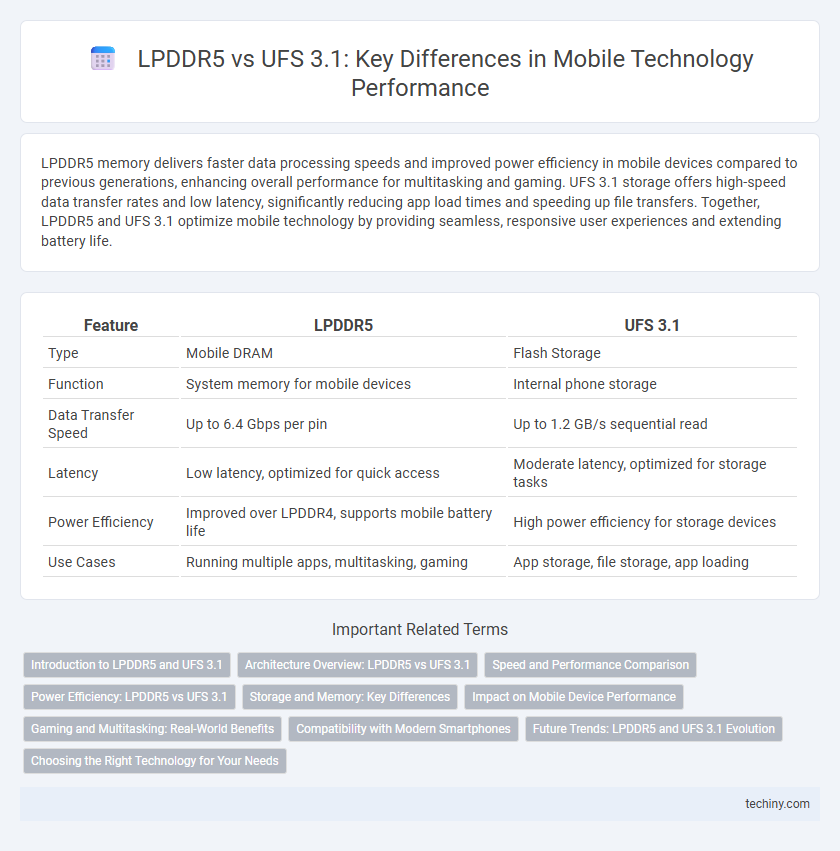LPDDR5 memory delivers faster data processing speeds and improved power efficiency in mobile devices compared to previous generations, enhancing overall performance for multitasking and gaming. UFS 3.1 storage offers high-speed data transfer rates and low latency, significantly reducing app load times and speeding up file transfers. Together, LPDDR5 and UFS 3.1 optimize mobile technology by providing seamless, responsive user experiences and extending battery life.
Table of Comparison
| Feature | LPDDR5 | UFS 3.1 |
|---|---|---|
| Type | Mobile DRAM | Flash Storage |
| Function | System memory for mobile devices | Internal phone storage |
| Data Transfer Speed | Up to 6.4 Gbps per pin | Up to 1.2 GB/s sequential read |
| Latency | Low latency, optimized for quick access | Moderate latency, optimized for storage tasks |
| Power Efficiency | Improved over LPDDR4, supports mobile battery life | High power efficiency for storage devices |
| Use Cases | Running multiple apps, multitasking, gaming | App storage, file storage, app loading |
Introduction to LPDDR5 and UFS 3.1
LPDDR5 is the latest generation of low-power DDR memory designed for mobile devices, delivering higher data rates up to 6400 Mbps and improved power efficiency compared to previous versions. UFS 3.1 is an advanced storage interface offering sequential read speeds up to 2100 MB/s and enhanced reliability through features like Write Booster and Deep Sleep mode. Together, LPDDR5 and UFS 3.1 significantly boost mobile device performance, supporting faster app loading, multitasking, and energy-efficient data handling.
Architecture Overview: LPDDR5 vs UFS 3.1
LPDDR5 is a dynamic random-access memory (DRAM) standard designed for mobile devices, offering high data transfer rates up to 6400 Mbps and improved power efficiency through architectural enhancements like differential clocking and deep sleep modes. UFS 3.1 is a flash storage specification optimized for fast sequential and random read/write speeds, leveraging a serial interface and command queuing to achieve up to 2900 MB/s throughput with low latency. The architecture of LPDDR5 centers on volatile memory storage for active processing tasks, while UFS 3.1 focuses on persistent storage management, highlighting their complementary roles in mobile technology performance.
Speed and Performance Comparison
LPDDR5 offers advanced RAM speeds up to 6400 Mbps, enhancing multitasking and gaming performance by reducing latency and increasing data bandwidth. UFS 3.1 storage delivers sequential read speeds up to 2100 MB/s and write speeds around 1200 MB/s, significantly improving app loading times and large file transfers. Together, LPDDR5 memory and UFS 3.1 storage enable faster data access and seamless user experiences in mobile devices.
Power Efficiency: LPDDR5 vs UFS 3.1
LPDDR5 RAM delivers superior power efficiency by utilizing dynamic voltage scaling and deep sleep modes, reducing power consumption by up to 30% compared to previous generations. UFS 3.1 storage achieves enhanced power efficiency through improved command queuing and faster data transfer rates, cutting energy usage during read/write cycles by approximately 20%. Both LPDDR5 and UFS 3.1 significantly extend battery life in mobile devices through their optimized low-power operations tailored for memory and storage tasks.
Storage and Memory: Key Differences
LPDDR5 enhances mobile device memory by delivering up to 51.2 GB/s bandwidth and improved power efficiency compared to previous generations. UFS 3.1 serves as a high-speed storage interface, offering sequential read speeds up to 2100 MB/s and improved random performance for faster app loading and file transfer. The key difference lies in LPDDR5 managing volatile memory operations for active data processing, while UFS 3.1 handles non-volatile storage responsible for permanent data retention.
Impact on Mobile Device Performance
LPDDR5 memory significantly enhances mobile device performance by delivering faster data transfer rates up to 6400 Mbps, improving multitasking and power efficiency in smartphones. UFS 3.1 storage offers superior read/write speeds, reaching up to 2100 MB/s, which accelerates app loading times and file transfers. The combination of LPDDR5 RAM and UFS 3.1 storage maximizes overall system responsiveness and energy management, critical for modern mobile applications and gaming experiences.
Gaming and Multitasking: Real-World Benefits
LPDDR5 memory delivers faster data transfer rates up to 6,400 Mbps, significantly enhancing gaming performance by reducing loading times and enabling smoother multitasking with multiple apps. UFS 3.1 storage offers sequential read speeds up to 1,500 MB/s, allowing rapid game asset loading and quick app launch times, which improves overall responsiveness in complex gaming environments. The combination of LPDDR5 RAM and UFS 3.1 storage provides a seamless gaming experience with minimal lag and efficient background multitasking on modern mobile devices.
Compatibility with Modern Smartphones
LPDDR5 memory offers enhanced speed and power efficiency in modern smartphones, supporting high-performance processors and demanding multitasking environments. UFS 3.1 storage provides faster data transfer rates and improved power management, optimizing app load times and file access. Both LPDDR5 and UFS 3.1 are widely compatible with flagship and mid-range devices, enabling seamless integration for enhanced user experience.
Future Trends: LPDDR5 and UFS 3.1 Evolution
LPDDR5 memory and UFS 3.1 storage are evolving to meet increasing demands for higher bandwidth and energy efficiency in mobile technology, with LPDDR5 offering up to 51.2 GB/s data rates and UFS 3.1 delivering sequential read speeds around 2100 MB/s. Future trends indicate LPDDR5X and UFS 4.0 will push these limits further, enhancing multitasking, AI processing, and 8K video capabilities. These advancements support the rapid growth of 5G networks and AI-driven applications, ensuring smoother, faster user experiences.
Choosing the Right Technology for Your Needs
LPDDR5 memory offers faster data transfer rates up to 6400 Mbps and improved power efficiency, making it ideal for intensive applications like gaming and AI processing. UFS 3.1 storage delivers sequential read speeds up to 2100 MB/s, enhancing app loading times and file transfers in smartphones. Selecting between LPDDR5 and UFS 3.1 depends on prioritizing either volatile memory performance for multitasking or high-speed non-volatile storage for faster data access.
LPDDR5 vs UFS 3.1 Infographic

 techiny.com
techiny.com